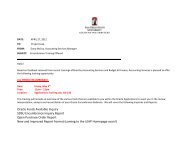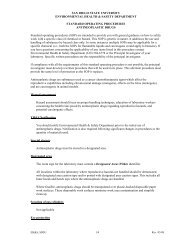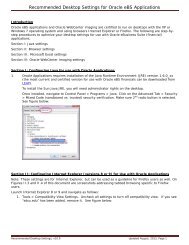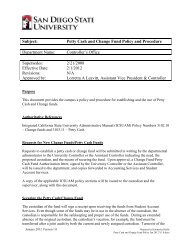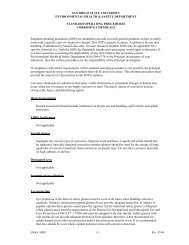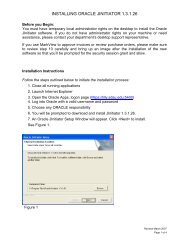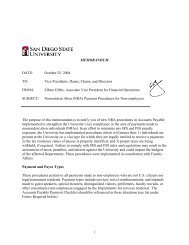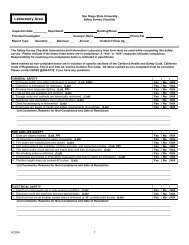Bloodborne Pathogen Training for Plumbing - San Diego State ...
Bloodborne Pathogen Training for Plumbing - San Diego State ...
Bloodborne Pathogen Training for Plumbing - San Diego State ...
You also want an ePaper? Increase the reach of your titles
YUMPU automatically turns print PDFs into web optimized ePapers that Google loves.
<strong>Bloodborne</strong> <strong>Pathogen</strong> <strong>Training</strong><strong>for</strong> <strong>Plumbing</strong>(CA Code of Regulations, Title 8, Sec. 5193)Millie Tran and Sheryl MajorDepartment of Environmental Health and Safety<strong>San</strong> <strong>Diego</strong> <strong>State</strong> University
<strong>Training</strong> Elements• Copy and Explanation of the BBP Standard• Epidemiology and Symptoms• Modes of Transmission• Employer and Site-specific Exposure Control Plan• Exposure Determination• Hazard Recognition / Risk of Exposure / Identification of ExposureSituation• Use of Engineering Controls, Work Practices and Personal ProtectiveEquipment• Decontamination and Disposal• Hepatitis B Vaccination and Program• Emergency Reporting and Response• Exposure Incident• Post-Exposure Evaluation and Follow-up• Signs and Labels• Live question and answer sessions
OSHA’s <strong>Bloodborne</strong> <strong>Pathogen</strong>Standard1) limits occupational exposure to blood andother potentially infectious materials sinceexposure could result in transmission ofbloodborne pathogens that could lead todisease and death2) by protecting workers against thisexposure3) thus reducing their risk from this exposure
Who is Covered by this Standard?• All employees who could “reasonablyanticipate” as the result of per<strong>for</strong>ming theirjob/duties contact blood and otherpotentially infectious materials• “Good Samaritan” acts such as assisting aco-worker with a nosebleed would not beconsidered occupational exposure
Could You Contract a <strong>Bloodborne</strong><strong>Pathogen</strong> Doing This at Work?• Administering First-Aid?• Cleaning the restroom?• Using a tool covered with dried blood?• A co-worker sneezes on you?• Working in a sewer manhole?• Shaking a sick coworkers hand?• Cleaning up after an accident?• Cutting yourself with a metal pipe that iscontaminated with blood?
Some Workers Who are at Risk• Physicians, nurses and emergency room personnel• Dentists and other dental workers• Laboratory and blood bank technologists and technicians• Medical examiners• Morticians• Law en<strong>for</strong>cement personnel• Firefighters• Paramedics and emergency medical technicians• Anyone providing first-response medical care• Medical waste treatment employees• Home healthcare workers• Orderlies, housekeeping personnel, and laundry workers
Potential ExposureApproximately 5.6 million workers in health careand other facilities are at risk of exposure tobloodborne pathogens.
Other Potential Exposure• Industrial Accident• Administering First-Aid• Post Accident Clean-up• Janitorial or Maintenance Work
Potential Transmission• Most common: needlesticks• Cuts from othercontaminated sharps(scalpels, broken glass, etc.)• Contact of mucousmembranes (<strong>for</strong> example,the eye, nose, mouth) orbroken (cut or abraded) skinwith blood or otherpotentially infectious material
Blood means:Blood and Other PotentiallyInfectious Materials• Human blood, human blood components, and productsmade from human bloodOther Potentially Infectious Materials• Human body fluids (cerebrospinal, peritoneal, synovial,pleural, pericardial, amniotic fluid, semen, vaginalsecretions)• Other body fluid visibly contaminated with blood i.e. saliva,vomitus• All body fluids where it is difficult to differentiate betweenbody fluids i.e. emergency response situation
<strong>Bloodborne</strong> <strong>Pathogen</strong>s<strong>Pathogen</strong>ic microorganisms that are present in human bloodand can cause disease in humans.<strong>Bloodborne</strong> <strong>Pathogen</strong>s include, but not limited to:• Human immunodeficiency virus (HIV) ~ AIDS• Hepatitis B virus (HBV) ~ Hepatitis B• Hepatitis C virus (HCV) ~ Hepatitis C• Malaria• Syphilis• Brucellosis
HIV• Source of virus• Blood, body fluids, breast milk• Route of Transmission• Transfer or direct contact with infected body fluids• Broken skin, mucous membrane• HIV attacks the persons immune system and causes it tobreak down, making the person more susceptible to otherdiseases/viruses• HIV has a low survival rate outside of the body• Detection can be delayed due to HIV’s ability to integrateinto the host DNA and remain inactive• CDC Report: Approximately 40,000 new HIV infectionseach year. Approximately over 1 million Americans areliving with HIV
HIV• Stages of Infection• Category A = asymptomatic, virus is inactive,but present• Category B = chronic yeast infections, shingles,thrush, fever• Category C = AIDS, TB infection, pneumonia,toxoplasmosis of the brain
Hepatitis• Inflammation of the liver• Chronic cases can lead to liver damage and liver failure• Symptoms include: jaundice, fatigue, abdominal pain, loss ofappetite, intermittent nausea, vomiting• Detection can be delayed due to slow response of body toproduce antibodies <strong>for</strong> the viruses• HBV can survive <strong>for</strong> at least one week in dried blood• CDC Report: Approximately 60,000 new HBV infectionseach year. Approximately 1 million Americans are livingwith HBV• CDC Report: Approximately 26,000 new HCV infectionseach year. Approximately 3 million Americans are livingwith HCV.
HepatitisSource ofVirusRoute ofTransmissionChronicInfectionHep A Hep B Hep C Hep D* Hep EFecesFecaloralBlood/BodyfluidsBrokenskin,mucousmembrane,SexualcontactBlood/BodyfluidsBrokenskin,mucousmembraneBlood/BodyfluidsBrokenskin,mucousmembraneFecesFecal-oralNo Yes Yes Yes NoPrevention Vaccine Vaccine ModifiedbehaviorBloodscreeningModifiedbehaviorHBVvaccineEnsuresafedrinkingwater
Exposure Control Plan• Identifies jobs and tasks where occupational exposure toblood or other potentially infectious material occurs• Describes how the employer will:• Implement universal precautions• Ensure use of engineering and work practice controls• Ensure use of personal protective equipment• Provide hepatitis B vaccinations• Provide post-exposure evaluation and follow-up• Use signs and labels• Provide training• Maintain sharps injury log• Plan must be reviewed annually• Plan must be accessible to employees
Exposure Determination• As required by OSHA, exposure evaluations willbe per<strong>for</strong>med in accordance with a categorizationscheme based on the potential of job-related tasksleading to exposure.• The three categories used are:• Category 1: Tasks that involve exposure to blood, bodyfluids or tissues.• Category 2: Tasks that involve no exposure to blood,body fluids or tissues, but employment may requireper<strong>for</strong>ming unplanned Category 1 procedures.• Category 3: Tasks that involve no exposure to blood,body fluids or tissues and Category 1 tasks are not acondition <strong>for</strong> employment.
Employee Job AssignmentsDepartment Employee Assignment GuidelineCategoryAthleticsTrainers (including paid studenttrainers)1-2Associated Students –Recreation & FitnessAssociated Students –ChildcareAztec Shops – FoodServiceTrainers. Technicians, InstructorsLifeguardsTeachers, childcare providers,assistants (including student assistants)Food Service Employees 2222HousingCustodial Services, MaintenanceWorkers2Public Safety Officers 2Physical PlantCustodial Services, <strong>Plumbing</strong>, Grounds,Maintenance Workers2
Universal Precautions• Treat all human blood and other potentiallyinfectious fluids as if they are infectious• Must be observed in all situations wheredifferentiation between body fluid types isdifficult or impossible - all body fluids shallbe consideredpotentially infectiousmaterials.
Engineering and Work PracticeControlsThese are the primary methods used tocontrol the transmission of bloodbornepathogens from blood or OPIM as aresult of splashing, spraying, andaerosolization.
Engineering ControlsThese controls reduce employee exposureby removing the hazard.Examples:• Safety guards on tools• Sharps disposal container
Workplace ControlTheseprecautions/controlsreduce the likelihoodof exposure by alteringhow a task isper<strong>for</strong>med.• Housekeeping Precautions• First-Aid Precautions
Housekeeping Precautions• Wash hands as soon as possible aftercontamination (i.e. work with sewer systems) andafter removing gloves• Do not pick up broken glass directly with hands• Clean and decontaminate equipment and surfacesthat had contact with infectious materials.• Do not handle items such as pens or door handleswhile wearing contaminated gloves.• No food or drink in work areas• No smoking in work areas
First-Aid PrecautionsTo protect yourself during an injury or accident:• Protect yourself be<strong>for</strong>e offering assistance• Wear clean, leak-proof disposable gloves• Be aware of personal cuts or broken skin be<strong>for</strong>e donning gloves• If no gloves are available, try to have co-worker self administer firstaid• Do not be careless about treating a co-worker’s bleeding injury• If blood is spraying, protect your eyes nose and mouth withgoggles and a mask• Keep blood off of you while you control bleeding.• Treat all contact with blood or bodily fluids as if it is pathogenic• Com<strong>for</strong>t the Victim and wait <strong>for</strong> trained emergencyresponders
First-Aid PrecautionsIf you get blood on you:• Wash it of as soon as possible with soapand water• Immediately flush your eyes with runningwater at a sink or eyewash station• Report the incident to your supervisor
Protective Clothing or EquipmentWhen occupational exposure remains afterengineering and work practice controls are putin place, personal protective equipment (PPE)must be used.• Specialized clothing or equipment worn by anemployee <strong>for</strong> protection against infectiousmaterials• Must be provided, properly cleaned, laundered,repaired, and disposed of at no cost to employees• Must be removed when leaving area or uponcontamination
Examples of PPE• Gloves – replace immediately when visibly soiled,torn, cut, or punctured; not be worn outsidecontaminated areas• Protective clothing/Footwear – shall be worn as aneffective barrier against blood and OPIM• Face shields and eye protection – shall be wornwhenever splashes, spray, spatter, droplets, oraerosols may be generated causing eye, nose, mouthcontamination• Mouthpieces and resuscitation devices
Decontamination and Disposal• Wear protective gloves• Disinfectant:• Solution of ¼ cup bleach per gallon of water• If cleaning up dried blood/body fluids ontools/equipment:• Spray with bleach solution• Wipe with paper towel• Properly dispose of contaminated PPE, towels,rags in a red bag inside a secondary containerwith a biohazard label on the outside of thecontainer and lid
Biohazard Warning Label• Warning labels requiredon:• Containers of regulatedbiohazard red bags and redsharps container• Refrigerators, freezers, andother equipment containingblood and other potentiallyinfectious materials• Other containers used tostore, transport, or shipblood or other potentiallyinfectious materials• Biohazard labeled red bagsor containers may besubstituted <strong>for</strong> sticker labels
Hepatitis B Vaccination Requirements• Must make available, freeof charge at a reasonabletime and place, to allemployees at risk ofexposure within 10working days of initialassignment unless:• employee has had thevaccination• antibody testing revealsimmunity• The vaccination must beper<strong>for</strong>med by a licensedhealthcare professional
Hepatitis B Vaccination Requirements• Must be provided even if employee initiallydeclines but later decides to accept thevaccination• Employees who decline the vaccination must signa declination <strong>for</strong>m• Employees are not required to participate inantibody prescreening program to receivevaccination series• Vaccination booster doses must be provided ifrecommended by the U.S. Public Health Service
Hepatitis A Vaccine• The vaccination must be per<strong>for</strong>med by a licensedhealthcare professional• Currently, four inactivated vaccines against HAV areinternationally available. All four vaccines are safe andeffective, with long-lasting protection.• Vaccine is administered in two doses 6-18 months apart• Not required by regulation to be provided by employer;however, it is highly recommended to receive thevaccination from your primary care physician• For more in<strong>for</strong>mation please visit the Word HealthOrganization websitehttp://www.who.int/vaccines/en/hepatitisa.shtml or theCenters <strong>for</strong> Disease Control and Preventionhttp://www.cdc.gov/hepatitis
Exposure Incident• A specific incident with contact with blood orOPIM• If there are no infiltration of mucousmembranes or open skin surfaces, it is notconsidered an exposure incident• Report all incidents involving blood or bodilyfluids
What to do if an exposure occurs?Employee must:• Wash exposed area with soap and water• Flush splashes to nose, mouth, or skin with water• Irrigate eyes with water or saline• Report the exposure incident to supervisorNote: Treatment should begin as soon as possibleafter exposure, preferably within 24 hours, and nolater than 7 days.BBP Exposure including needlestick is referred toSharp Rees-Stealy Occupational Medicine orUrgent Care (619) 644-6600
Health Provider must:• Obtain sample from source individual and the exposed employee and testblood as soon as possible after the exposure incident and after consent isobtained• Provide written opinion of findings to employer and copy to employee within15 days of the evaluation• Employee shall be advised of regulations concerning disclosure of theidentity ad infectious status of the source individual• Provide risk counseling and offer post-exposure protective treatment <strong>for</strong>disease when medically indicated in accordance with current U.S. PublicHealth Service guidelinesPost-Exposure Follow-UpEmployer must:• Direct the worker to a healthcare professional (Sharp Rees-StealyOccupational Medicine or Urgent Care) (619) 644-6600• Document routes of exposure and how exposure occurred in the ExposureIncident Form• Identify and obtain consent from the source individual if legally required• Record sharps injuries and type of sharps involved in the sharps injury log
Medical RecordkeepingRequirements• Employee’s name and social security number• Employee’s hepatitis B vaccination status• Results of examinations, medical testing, and postexposureevaluation and follow-up procedures• Health care professional’s written opinion• In<strong>for</strong>mation provided to the health care professional• Employee medical records must be kept confidential andnot disclosed or reported without the employee’s writtenconsent (unless required by law)• Medical records must be maintained <strong>for</strong> duration ofemployment plus 30 years according to OSHA’s rulegoverning access to employee exposure and medicalrecords
<strong>Training</strong> Requirements• Provide at no cost toemployees during workinghours• Provide at time of initialassignment to a job withoccupational exposure andat least annually thereafter• Additional training neededwhen existing tasks aremodified or new tasks arerequired which affect theworker’s occupationalexposure• Maintain training records<strong>for</strong> 3 years
<strong>Training</strong> Elements• Copy and Explanation of the BBP Standard• Epidemiology and Symptoms• Modes of Transmission• Employer and Site-specific Exposure Control Plan• Exposure Determination• Hazard Recognition / Risk Identification• Use of Engineering Controls, Work Practices and PPE• Decontamination and Disposal• Hepatitis B Vaccination• Emergency Reporting and Response• Exposure Incident• Post-Exposure Evaluation and Follow-up• Signs and Labels• Live question and answer sessions
Summary• OSHA’s <strong>Bloodborne</strong> <strong>Pathogen</strong>s standardprescribes safeguards to protect workers againstthe health hazards from exposure to blood andother potentially infectious materials, and toreduce their risk from this exposure• Implementation of this standard not only willprevent hepatitis B cases, but also will significantlyreduce the risk of workers contracting AIDS,Hepatitis C, or other bloodborne diseases
Case StudyYou and a coworker are changing plumbingfixtures during a renovation when yourcoworker cuts himself with a sawzall andbegins bleeding profusely.• Do you immediately apply direct pressure to theinjury?• Do you know where the first-aid kit is?• Do you stay in the area or move out of the workspace?• What do you say to other coworkers in theconstruction site?
Case Summary• For your safety, have your injured co-worker applydirect pressure to his injury until you can getgloves from the first-aid kit• Once you have gloves, you can apply pressureyourself• Stay away from equipment as much as possible toavoid contamination• Let coworkers know there is an injury and warnthem to avoid contacting any blood spilled• Radio or report the injury to supervisor and followprocedures to get your co-worker medicalattention
Case StudyYou are disconnecting a leaking p-trap inStudent Health Srevices when you noticeblood had leaked from the trap andsplashed onto your hands and face.• Do you immediately wipe your hands and face?• Do you know where the next nearest sink withrunning water is?• Do you stay next to the blood spill?• Do you continue working in the area?• Do you clean-up the blood spill yourself?
Case Summary• First, locate the nearest working faucet and flushthe affected areas <strong>for</strong> 15 minutes.• In<strong>for</strong>m the building residents of the spill and thehazard posed with a blood spill, try and have themisolate the contaminated area.• Do not resume work until the supervisor has beennotified of your personal blood exposure and areport is filled out. Post-exposure evaluation willbe provided.• If a blood spill-kit is not available, contact workcontrol <strong>for</strong> custodial services. Do not resume workuntil blood contamination is disinfected.


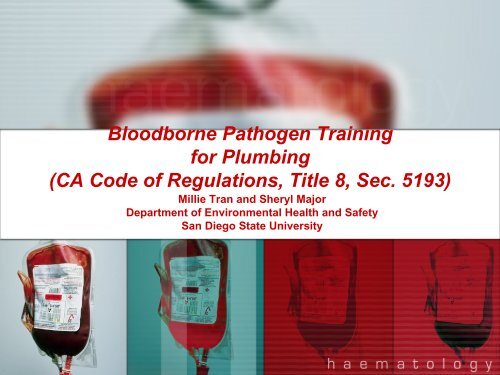
![Procurement Card Audit Program [PDF] - SDSU](https://img.yumpu.com/48908195/1/190x245/procurement-card-audit-program-pdf-sdsu.jpg?quality=85)
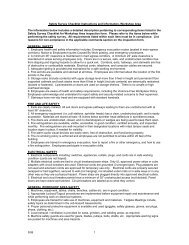
![Personal Protective Equipment [PDF]](https://img.yumpu.com/45263101/1/190x143/personal-protective-equipment-pdf.jpg?quality=85)
